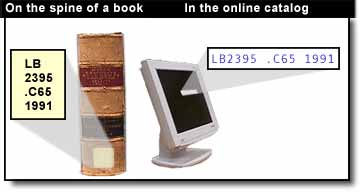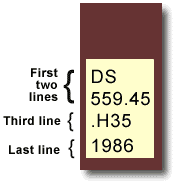Classification Systems / Shelving Schemes
Classification systems are used to organize the library's collections into subject categories, which means that books on the same subject will be grouped together and be shelved near each other. Click on the tabs below to explore the major classification systems used at the libraries.
Most of the collections at the Jean & Alexander Heard Libraries use the Library of Congress Classification System (LCC), which is a classification system developed by the Library of Congress and commonly used by academic libraries. This system allows us to easily and efficiently keep track of large numbers of books.
The LCC system allows books to be arranged by subject into 21 subject classes. Each book is assigned an alphanumeric call number based on its subject matter. These LCC call numbers are used to shelve books and shelf-read.

Note that the same call number can be written from top-to-bottom, or left-to-right.
For a detailed look at the LCC Classification Outline, click here.
Here is an example of the structure of a LC call number:
Book title: Uncensored War: The Media and Vietnam 
Author: Daniel C. Hallin
Call Number: DS559.46 .H35 1986
The first two lines describe the subject of the book.
DS559.45 = Vietnamese Conflict
The third line often represents the author's last name.
H = Hallin
The last line represents the date of publication and volume
Watch this two-minute video for an overview of how to read a call number:
If it would be helpful to watch a more in-depth video, click here for a more detailed perspective.
How to read a call number: Read call numbers line by line:
LB
Read the first line in alphabetical order: 
A, B, BF, C, D... L, LA, LB, LC, M, ML...
2395
Read the second line as a whole number:
1, 2, 3, 45, 100, 101, 1000, 2000, 2430...
.C65
The third line is a combination of a letter and numbers. Read the letter alphabetically. Read the number as a decimal, eg:
.C65 = .65 .C724 = .724
Some call numbers have more than one combination letter-number line.
1991
The last line is the year the book was published. Read in chronological order:
1985, 1991, 1992...
Volume Numbers
Sometimes a call number will contain a volume number, labeled v.1, v.2, etc. These are shelved in whole number numerical order within the set of books.
Copy Numbers
A call number will contain a copy number if there are multiple copies of the same book on the shelf, labeled c.1, c.2, etc. These are shelved in whole number order.
One thing to always keep in mind when shelving books and shelf-reading is that nothing comes before something.
If a book contains no volume number, that book comes before a book within a set that does contain a volume number. If a book contains no date in the call number, that book comes before the same book that does have a date in the call number.
Here is a shelf of books with the call number order explained:

This is a system for organizing the contents of a library based on the division of all knowledge into 10 groups. Each group is assigned 100 numbers and is subdivided into decimals. Some older documents in the library may use the Dewey Decimal system.
Reading Dewey Decimal Call Numbers
- Every Dewey Decimal (DDC) call number begins with three numbers (003 is never written as 3 in DDC), some with decimal numbers followed by various letters, and/or number combinations.
- Numbers to the left of the decimal point in Dewey call numbers are whole numbers. Therefore, 015 comes before 150.
- Numbers to the right of the decimal point in DDC call numbers are decimal numbers. Therefore, 970.13 comes before 970.3
Books in the Biomedical Library are catalogued using the NLM Classification. This classification includes the areas of medicine and related sciences, and uses the schedules QS-QZ as well as W-WZ, which are not used in the LC classification.
Further information pertaining to the reading of an item’s call number may be found under the “Biomed” tab – Eskind Library Student Training: Stack Maintenance.
Students working in the Eskind Library need to familiarize themselves with the NLM Classification, and check with the supervisor if there are any questions regarding book shelving at the Biomedical Library.
SuDocs is the "Superintendent of Documents" classification system used for federal government publications. Government depository items are the only items in the library that use this classification system.
The main way to differentiate a SuDoc call number from other classification systems is that a Sudoc number will always have a colon : in the number.
SuDoc numbers are arranged similiarly to LC numbers in that they always go in alphabetical and numerical order. However, in SuDocs, any numbers after a decimel . are read as WHOLE numbers, while in LC numbers after a decimel are, well, decimel numbers.
Sudoc: A 10.23 = 23 is a whole number, coming after A 10.3 and before A 10.124.
LC: A 10.23 = .23 is a decimal number, coming after A 10.124 and before A 10.3.
